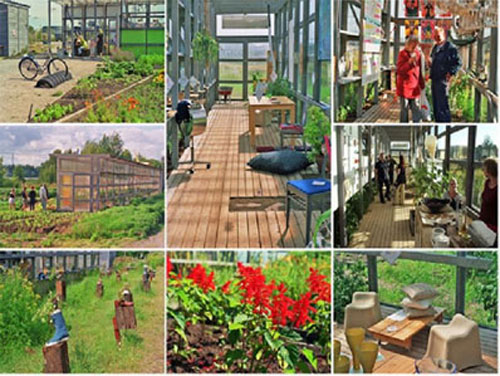‘HAPPIHUONE’ CULTURAL GREENHOUSE

a greenhouse and exhibition centre in the city centre
Key Innovation
A greenhouse and garden in the city centre that serves as a forum for environmental art and design exhibitions, workshops, and lectures.
Problematic background and context
The cultural greenhouse project began in the year 2000 when Helsinki was one of Europe’s Cultural Capitals. One well-known painter suggested building a greenhouse out of old windows, use it as an exhibition space and café, and have a surrounding garden with vegetable plots for urban-dwellers. A Swedish-speaking women’s network evolved nearly spontaneously around this project. It was built as part of a larger Art Garden, in an underdeveloped park area whose future remains controversial in terms of urban planning and cultural diversity vs commercial development. The next year it was not disassembled as planned but was instead bought and used by a Winter Light festival, and then by o2 Finland, a non-profit association of sustainability-oriented designers. o2 Finland continued in subsequent summers to organise and curate various eco-design and environmental art exhibitions; to operate the café themselves or with interested fair trade partners; to invite non-profit groups to give lectures and arrange discussions; to invite experts to give free workshops on e.g. natural textile dyeing from the plants growing in the greenhouse’s own garden; to provide a venue for music, dance and theatre; to sell pick-your-own organic vegetables from the garden, and even offer a highly popular seat in the peat-brick smoke sauna. As the o2 Finland network has widened, individuals and groups have been motivated to join the activities, especially in cases when e.g. their artistic production would not suit a mainstream gallery, they become interested in the garden, they wish to find an alternative (and cheaper) venue to perform musically, and so on.
Solution description
The aim of the solution is to, first, provide a flexible cultural platform for interested parties whose activities may be deemed ‘sustainable’, and secondly, to educate the general public on sustainable lifestyles and design, functional plants, and alternative art and artists. It also acts as an urban garden oasis where visitors can relax with a fair trade coffee or tea, minutes from the central railway station. Interested groups and individuals can join o2 Finland’s group by membership or via the e-mail list to learn about the activities and help put on exhibitions. The venue is available for various purposes, usually for a small fee. Larger events and exhibitions are funded via grants and sponsors. Most of the physical work is done by volunteers. The innovation is interesting especially because of its temporality: intended as a half-year project, the greenhouse still stands and continues to motivate artists and cultural actors to exploit its location and aesthetic environment. It is also difficult for the general public to ‘classify’: is it a real, functional greenhouse? Or a garden? An art piece? A café? A gallery? This makes it an especially interesting place.
Timeframe
from June 2000 to autumn 2005
Development phase
Diffusion:
The solution is a unique solution that is extremely context-specific.
Maturity:
The solution remains in its initial stages with some movement towards optimisation. Each year of operation is somewhat unique in its service offerings, whose management and operation depend on the individual/s in charge that particular year. ‘Lessons’ or ideas from previous years are taken on again or are discarded and new cooperation partners are found. Certain offerings (such as the cafe service or the textile workshops) remain relatively consistent and can be considered a ‘product in use’.
Revenue/costs model
The main source of financing is grants (e.g. city and state cultural funds). The grants are used for repair and maintenance, seeds and garden equipment, printing costs for brochures, and some wages. Exhibitors must pay rent for exhibition space; individuals can rent the building and sauna for private functions. The space for music and theatre performances, lectures and special events organized by other NGOs is usually offered free of charge. Visitors may buy coffee, tea and snacks from the café, which operates at cost.
Social evaluation
The greenhouse and area provide the city residents with an unusual place to visit and relax, to learn about and sometimes buy vegetables and functional plants, and to see unusual exhibitions. Groups such as fair trade associations may promote and teach about fair trade products through the cafe. Artists may display their work. A drawback is that there is much voluntary work, which requires a high level of motivation on the part of busy members.
Environmental evaluation
There are many educational lessons for visitors on the environmental benefits of functional plants such as flax and plants for natural dyes, on design-for-sustainability through exhibitions, and on the environmental value of the area, which is a popular nesting site for waterbirds.
Economical evaluation
The cafe system allows some income and promotional activities to those participating partners. Individuals such as students and artists gain summer employment through the employment office’s work placement programme. Exhibiting artists may sell their work. A drawback is that the greenhouse must survive on a grant-by-grant basis.
Authors
Cindy Kohtala / University of Arts and Design – Helsinki / Finland